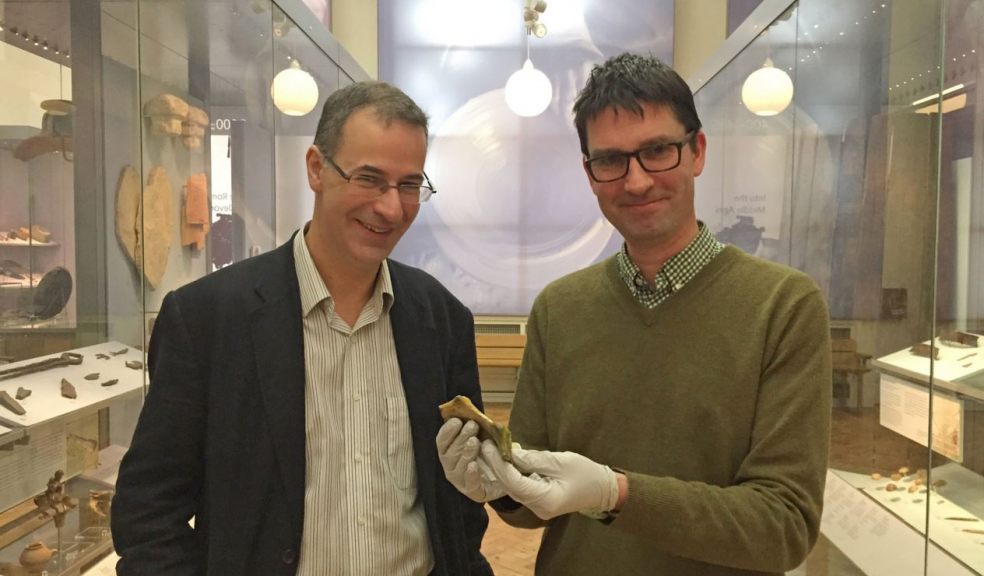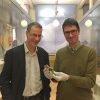
Uncovering secrets from Exeter’s hidden past
Secrets from Exeter’s hidden past will be uncovered in a major new archaeology project.
Lead by experts from the University of Exeter, the latest technology will be applied to RAMM’s collections to reveal where the city’s food and ceramics came from during 1st to the 16th centuries. The four-year study will show the extent of trading networks throughout the period and Exeter’s changing role within the region.
Project leader Professor Stephen Rippon, Professor of Landscape Archaeology at the University of Exeter, said: “There was a huge amount of excavation in Exeter in the 1970’s, due to big building projects at the time such as the Guildhall shopping centre. Now we have sophisticated techniques to analyse the findings from those digs. This will show the relationship that Exeter had with its local area, the South West and Europe. It will allow us to understand the economy in Exeter in the past, and what the Roman equivalent of what we describe now as our food miles were.”
Cllr Rachel Sutton, Lead Councillor for City Development, said “The city council is delighted to support this project as it will enable the important discoveries made by the council’s archaeologists in the 1970’s and 80’s to gain the wider recognition that they deserve, and the city’s pivotal role in the history of the South West, and its wider links abroad, to be more fully appreciated.”
Cllr Rosie Denham, Lead Councillor for Economy and Culture, said “Using the latest scientific techniques, this project will add to the myriad stories that RAMM’s collections tell about Exeter: about its origins, history, people, natural history and place in the world. Ancient objects excavated decades ago then catalogued and stored at RAMM can now reveal details of the local economy through the millennia; details that were unimaginable when the objects were found. Ingenuity, skill and science are key to Exeter’s future prosperity. It is wonderful to also see them helping us understand our past.”
There were excavations on 89 sites within the city between 1970 and 1990. The remains analysed as part of the project will include those from Friernhay Street, behind Fore Street, from the Guildhall Centre in central Exeter, and Rack Street on the edge of the city.
Urbanisation in Britain
The relationship between town and country has played an important role in shaping British society for much of the past two millennia. Britain's assimilation into the Roman world led to the creation of a network of towns as centres of administration, trade, industry and service provision although the decline of Roman Britain led to the disappearance of urban life in most areas. It was only from around the 10th century that true towns once again re-emerged, and they have been integral to British life ever since. This project will examine the fluctuating fortunes of the most important town in SW England - Exeter - and how it interacted with its local, regional and international hinterland.
The Development of Exeter
Exeter began in the Conquest period (c.AD55) as a Roman legionary fortress, and following its abandonment (c.AD75) it was transformed into a town (civitas capital) serving the local region of Dumnonia. Unlike many other lowland areas, Dumnonia was slow to adopt aspects of Roman life, there being very few villas and other forms of Roman influence in the countryside. As such, this project will use Exeter as an example of the development of urbanism at the fringes of Romanised Britain. Although large parts of the town appear to have been abandoned in the early medieval period, a thread of continuity is indicated by radiocarbon-dated burials from the Cathedral Close. Urban life in Exeter resumed around the 10th century, and the town continued to flourish throughout the medieval period when it established extensive trading connections with Atlantic Europe, once again demonstrating a model of urbanism that was different from the centres of power to the east.
Why Exeter?
Exeter's archaeological importance is two-fold: firstly, it is representative of urbanism in western Britain, well away from the political, social and economic centre of London; and secondly, there have been particularly extensive excavations the results of which have only partly been published. The Exeter: A Place in Time project therefore aims to produce the first ever synthesis of the archaeology of Exeter and undertake a series of themed research strands, based upon scientific analyses of previously excavated assemblages (animal bones, pottery, and metallurgical debris) that shed light on how the city developed and interacted with its hinterland.
The Project
Exeter: A Place in Time is a collaboration between the Universities of Exeter and Reading; English Heritage through their Centre for Archaeology and funding for Cotswold Archaeology; and Exeter City Council who run the City's Historic Environment Record and the Royal Albert Memorial Museum.
The findings
The project includes radiocarbon and dendrochronological dating and metallurgical analysis of objects in RAMM’s collections and researching unpublished excavation notes. The findings will be presented in two books, academic conferences and a public presentation. They will also enhance RAMM's Making History gallery, its online Time Trail, and the Historic Environment Record.

















